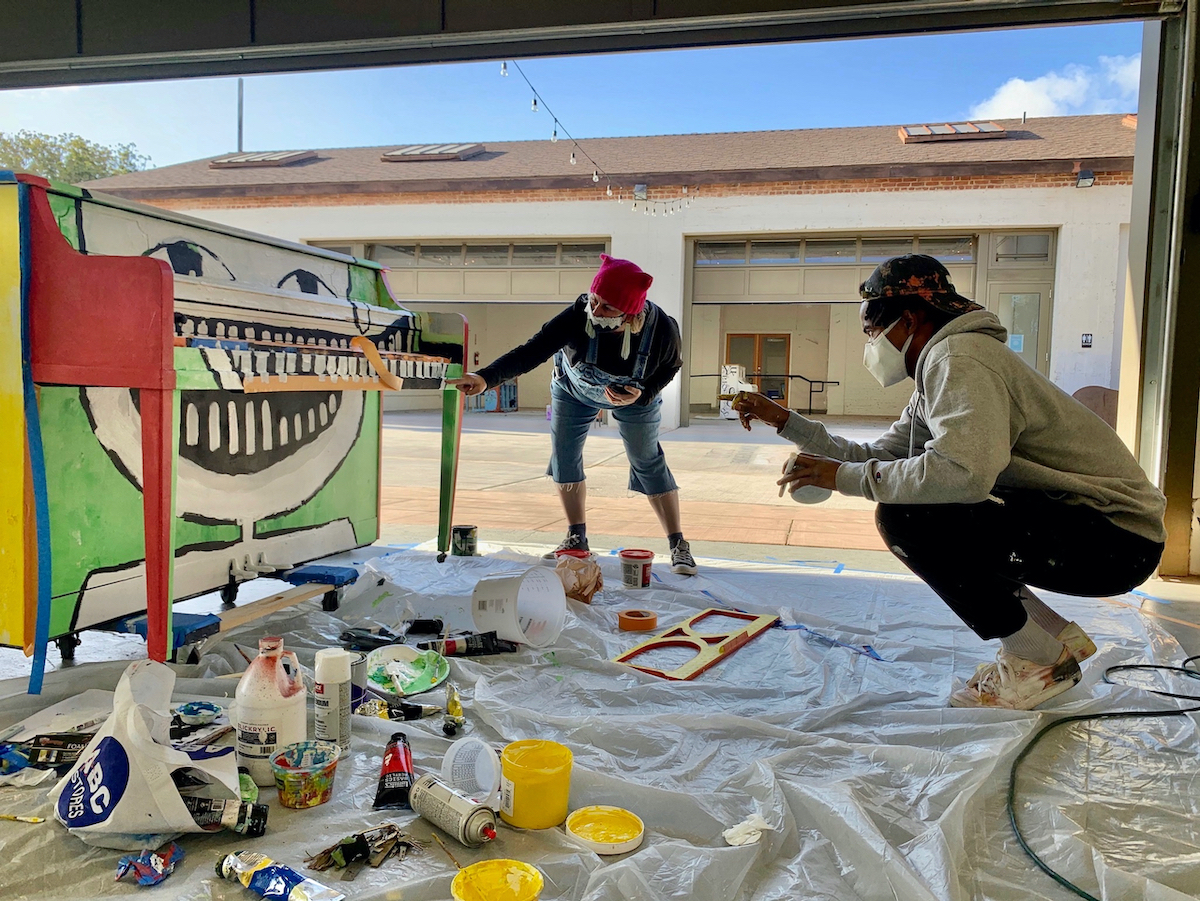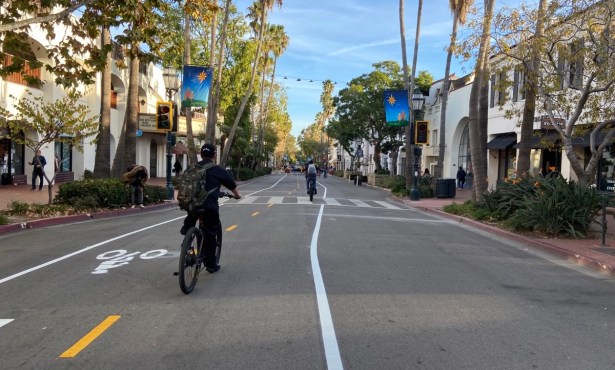Poodle | Can State Street Pianos Bring Rain to Santa Barbara?

TICKLED IVORIES: The painted pianos are back. For more than 10 years now, they magically appear on State Street around this time, usually but not always near busy intersections. They offer portals in invisible storms, an invitation for a musical dalliance, even for those who don’t play. Maybe especially for those of us who don’t play. If we’re lucky, these pianos — warbly of voice and never quite in tune — will be up for a couple of weeks. The sound of “Chopsticks,” Bartók, and Elton John will fill the air. Or maybe it will be a whole lot of random plinkety-plunk chasing each other across the keyboards like a cartoon cat chasing a cartoon mouse.
It doesn’t matter.
Total strangers will gather around these sonic campfires. For a moment, we will show off and laugh nervously, off-leash from our demographic silos. In that moment, we will not be strangers. Will the species be redeemed? Maybe not, but some great music will be born. For my money — and of course, it’s not — this is the single most effective investment anyone could imagine for State Street. Yesterday, I passed a middle-aged woman coaxing what I imagined was “Into Each Life Some Rain Must Fall” from a yellow upright. She missed a few notes, but it was still beautiful. “If only,” I thought, and walked on.
That morning, the Los Angeles Times informed me California just recorded the driest three successive years in recorded history, which for rain, it turns out, began in 1896. Naturally, I felt the urge to call up Joshua Haggmark, the city’s de facto and preternaturally cheerful water czar. What does this mean for Santa Barbara? I wanted to know. Haggmark, also preternaturally responsive, had this to say.
Nothing and everything.
The good news is that the last three years are not the driest on record for Santa Barbara. The bad news is that this doesn’t matter. That’s because eight of the last 10 years have been unusually dry. As a result, Lake Cachuma — where most of our water comes from — hasn’t spilled in 12 years. It used to spill every three.

The state water system — for which we spending umpteen millions a year — has got-ten so questionable that some board members are officially fretting the pipes could start to corrode because soon no water will be going through them. That’s a first. Or could be.
People living in the City of Santa Barbara are okay, at least for the time being, because 23 years ago, they had the sense to vote to build a desalination plant that could never have gotten approved in today’s environmental and regulatory climate.
In the past few months, platoons of construction workers have been busy inconveniencing our lives by digging up city streets and laying 10,000 feet of new water pipes — 24 inches in diameter, in case you’re interested. These will connect the desal plant — located in the industrialized zone just off the waterfront — to the Cater Water Treatment Plant located up and over Highway 192. From there, the desalinated water can be gravity-fed into every city household. Right now, it can only be pumped to households in the city’s lowlands. Normally, I’d say this was the smartest $20 million City Hall spent, but in this case, most of the money comes from an insurance settlement over damages done to our water system by the Thomas Fire.
Sign Up to get Nick Welsh’s award-winning column, The Angry Poodle delivered straight to your inbox on Saturday mornings.
In droughts past, the city bought supplemental water from massive ag operations that made more money selling water at exorbitant rates than growing cotton in the Mojave Desert. (And we wonder why we have a drought.) Given that the Colorado River is drying up — and Lake Mead and Lake Powell are only 25 percent full — the com-petition to buy water from those cotton and alfalfa growers is fierce.
The good news — if you happen to live in the City of Santa Barbara — is that 25 percent of the water in Lake Cachuma belongs to the city. The other good news is that city water customers are using 26 percent less than they were in 2013. That’s roughly 40 gallons a day indoors. The bad news is that Governor Gavin Newsom wants everyone to cut back by 25 percent, but not from 2013. He wants it from two years ago. For people on the South Coast — who never really stopped conserving — that will translate to a 36 per-cent reduction.
If push comes to shove, that shoe could get real tight. Or as they used to say, that’s a lot of yellow that will need to mellow.
And if things stay real dry, we have the capacity to triple the capacity of the desal plant. That, however, would be extremely expensive.
In the meantime, Haggmark is fielding phone calls from people who claim they can harvest water from fog, or want to cover the surface of Lake Cachuma with plastic balls to prevent water loss due to evaporation that takes place. Up at the Gibraltar Reservoir, there was talk of covering the surface with solar panels to do the same thing, but it turns out there’s no connection to the grid up there.
Given Santa Barbara’s New Age proclivities, I’m surprised we have no born-again shamans leading us in collective rain dances. In the Ozarks, I am told, some people entice the skies by hanging dead snakes belly-up on fence posts. I can’t swear by either method.
In this context, maybe we can consign the pianos now colonizing State Street to the cause. The timing, it turns out, is just about right, coming only one month before our so-called “rainy season” is scheduled to begin. By my reckoning, the worse we play, the more effective we’ll be. The skies will open up if only to shut us up.
Those pianos? They’re something beautiful.
Support the Santa Barbara Independent through a long-term or a single contribution.




You must be logged in to post a comment.